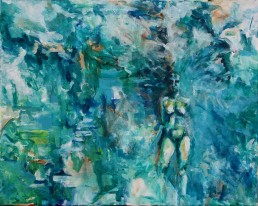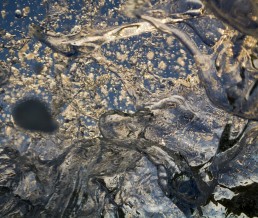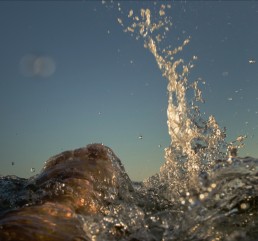
Joanna Frye, Untitled, 2017, Acrylic on Canvas
Sharks, Painting, and Patience
In our interview, artist and frequent ocean buddy Joanna Frye and I discussed the release from creative responsibility that comes with surfing. She said that when she surfed it felt like she was being painted instead of doing the painting. There is still plenty of creating going on when you surf or play in the ocean, it’s just not all coming out of your own limited human imagination and skillset. It’s not all dependent on your work. For those moments in the waves, you can’t even begin to lie to yourself about being in control of life, about dominating the world, or forcing an outcome. But you do, eventually, achieve some sense of control of your relationship to yourself and the uncontrollable.
Playfully, creatively tapping into a wider, deeper and, if you prefer, higher power is a practice that can, over time, change your mind and could do so, some neuroscientists think, by measurably changing your brain.

The research about the plasticity of our brains is thrilling but I don’t need a neuroscientist to tell me this: to catch a wave requires presence and acceptance: you can’t hurry things, or waste time thinking about the past or the future, or wish they were easier or more interesting. There just isn’t time for that. Not if you want to be there for that ride, to feel the rush and lift, and respond in whatever way your own body will allow, to be with that force for a delicious instant, to feel the joy of being on a planet with gravity instead of putting your creative energy into the futile task of working to somehow defy it.
One of the 20th Century philosophers I think is worth wrestling with is Maurice Merleau-Ponty. He wrote that “[t]rue philosophy consists of re-learning to look at the world.” It’s a pretty inclusive definition and seems to include those of us who are honest and brave enough to know that we need to revise our vision as we, our insights, and the world change. Merleau-Ponty’s work focused on that instant of perception, a sliver of time before our scientific, categorical mind can take over and begin to catalog, dismiss, prioritize, and judge. He thought this moment of perception was the beginning of all creativity, all art.
He wrote that “it is the expressive operation begun in the least perception, which amplifies into painting and art.” He also thought painters were uniquely well suited “amplifiers.”
Carolyne Quinn wrote a wonderful, accessible article about Merleau-Ponty’s work on perception and painting. Quinn writes that, for Merleau-Ponty “meaning is not found pre-existent in the world but is called into existence by the body’s own activity in the world.”
Merleau-Ponty’s work is more popular since his death than during his life because, as it turns out, his writing is more relevant to what we’re learning about our brains now than what we knew about them then. Think about it. If he’s even a little right, and we are dependent on our sensing bodies to help create meaning, what are our hyper-stimulated, scanning, swiping, fractured, and busy days doing, not just to our bodies, but to the meaning we call into existence in the world.
Quinn describes one of Merleau-Ponty’s most inspiring ideas, something called “reversibility.” Merleau-Ponty thought our body is both an entity that senses and an entity being sensed, and not just in the way your body is busy seeing and being seen by other partially dressed humanoids on the beach, but in the touch of a tree or a rock or a wave. You can be altered by the wave and the wave by you. Everyone who plays in the ocean knows this to be true. Merleau-Ponty just expands that intuitive understanding to encompass all perception. He thought that to understand either side of perception- being touched or touching, we needed to know they were not wholly separate, not either/or, and not one and the same. Instead, they overlap, both always part of any perception we have of the other. He thought most of us walk around with limited vision that ignores much of the rich, invisible depth of being sensed by the other. But not painters. According to Merleau-Ponty, while the rest of us (including photographers) couldn’t get at the real substance of perception, painters could render the invisible visible to the rest of us. Their paintings had the potential to render some of this fluid motion, this oscillation between seeing and being seen.
Because I live on the coast, because it’s the discipline at the center of my work and life, because it makes me feel sane, and is just too damn too beautiful to miss, I get in the ocean almost every day. A few weeks ago I hurt my rib in an unlucky fall and, while it’s been healing, I’ve been going in with my camera instead of my surfboard, photographing in the small, late summer waves each dawn and early morning. There are fewer black skimmers and the fish are starting to return in droves, each peaking shore break wave filled with dozens. My own species has begun its daily turtle walks. One one level, they’re out there looking for signs of nesting. But really, I think they are looking to call the meaning of hope into existence, walking with the hope that, for some perceiving moment in the future, they might dig a trench or hold a light that could help hatchlings, endangered as individuals and species, along their way. Even if they don’t save every turtle, they might save themselves.
Today, between sets of waves, a small shark swam from behind me, passing me on the right at a slow, leisurely pace— maybe there’s food aplenty. Rushing isn’t a priority. It must have seen me before I saw it, just so much inedible flotsam.The moment I saw its fin break the water, that instant of perception before I could categorize, the moment when my animal brain registered its size relative to mine (it was tiny, maybe 2 feet long), at its presence in the water, right there, with me, seeing me, and the resulting elation I felt at being seen (if it had been 2 meters long, I expect my perceptions might have been… different),— all reminded me of both Merleau-Ponty, and one of Joanna’s paintings that hangs on my wall, one that evokes something of immersion in liquid and light and motion, just like this morning. Reminding is a word we often say but don’t appreciate. To remind yourself is not just to recall, but to restore your mind to something valuable. I love that painting because it feels like the dissolution that happens to me in the ocean, the unimportant stresses and worries gradually losing concentration until they wind up just disappearing, and, even if they return, the wisdom and perspective that comes from the their intermittent disappearance endures.
Philosophers have been imploring us for a long time to learn to accept what we can’t change. The Stoics of Ancient Greece did it. Some Buddhists did (and do) it. The Serenity Prayer does it. But most of us still suck at it: quick to irritation or anger or a wish for a trap door into which you might dispense with or exchange the reality of the aggressive driver, the glitchy gadget, the broken rib- there are so many situations in our daily lives that regularly, reliably immerse us in stress, even when everything’s going “right.”

As soon as I realized my rib was well and truly hurt, that I might miss weeks of surfing these beautiful summer waves, I panicked. I didn’t want to miss waves. This was a disaster.
A minor one my brain scolded.
My feelings did not obey.
I began to focus on speed healing. Googling nutrition and bone injuries, stocking up on vegetables with Vitamin K (green cabbage has twice as much as red), doubling up on magnesium supplements, uncovering the miracle of comfrey (which is pretty miraculous). Maybe it was just a bad bruise and would be surfable in a few days?!? A couple of false starts over the next week helped me settle in. As a wise yoga teacher once told me, “If you get into a fight with your body, you are going to lose. Every. Single. Time.” Recovery would take exactly as long as it would take.
One of the primary, foundational motivations for this Waves to Wisdom project is finding ways to let others in on one of the central, grounding, and most useful working theories I’ve figured out in a long time spent figuring: our bodies and their perceptions are primary to what we create. What we experience when we are at play and deeply at home in our bodies, when these bodies we all have feel integrated into, even continuous with our larger home on the planet– these moments can be lessons that recast our lives; even the objects, people, and relationships that seem utterly familiar to us. We can perpetually see them anew and, in turn, be renewed in their eyes. The ocean is one particularly exciting and beautiful way to learn these lessons.
If, on the other hand, we spend all of our time scanning, slouching, and constricting, or dominating, forcing, and demanding, we can’t help but create meaning and methods to match. We value what will entertain or enrich us in our slouch instead of allowing ourselves the benefit of experiencing life elongated, expansive, fully oxygenated, and open to what’s right here and far away, open to the interdependence of self and other. We all sometimes allow the endless stream of information and news and wellness advice to overwhelm this moment, the only one we have, the one we don’t get back, the one in which someone nearby, a tree, a turtle, a neighbor, maybe even we ourselves, could benefit from some awareness of seeing and being seen.
That shark was today’s teacher and the painting it somehow called into my awareness the fortunate ongoing reminder of the lesson. I’ve been looking at it for a long time but I saw it anew today and it wasn’t anywhere in sight. I realized, without words, with the flick of the tip of undulating fin and tail, why I’ve loved it so much. That instant of sensing, of being sensed, being part of what Davis Abram calls “the biological matrix of life on the planet,” and being a person fortunate enough to return to walls and art and one painting in particular, was an exquisite episode of “reversibility.”
I owe that “unlucky” fall for the gift of this day sitting at my desk, rib healing, with the painting about as far away as the shark was, seeing me see it with reminded eyes.
For us too, if there’s enough food, maybe rushing doesn’t need to be a priority.
For information about retreats or to set up a free coaching session email maia@wavestowisdom.com.
Sources
Abram, David. “Merleau-Ponty and the Voice of the Earth.”Environmental Ethics, volume 10 (1988), pp. 101-120.
Cheron, Guy. “How to Measure the Psychological ‘Flow’? A Neuroscience Perspective.” Frontiers in Psychology 7 (2016): 1823. PMC. Web. 31 Aug. 2018.
“Maurice Merleau-Ponty (1908-1961)“. The Internet Encyclopedia of Philosophy
Staiger, Christiane. “Comfrey: A Clinical Overview.” Phytotherapy Research26.10 (2012): 1441–1448. PMC. Web. 31 Aug. 2018.
“Stoicism.” The Internet Encyclopedia of Philosophy
Quinn, Carolyne. “Perception and Painting in Merleau-Ponty’s Thought.” Paris III, Université de Sorbonne-Nouvelle/University College Dublin
